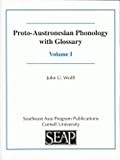Proto-Austronesian Phonology with Glossary / John U. Wolff.
Material type: TextPublisher: Ithaca, NY : Cornell University Press, [2018]Copyright date: ©2010Description: 1 online resource (586 p.)Content type:
TextPublisher: Ithaca, NY : Cornell University Press, [2018]Copyright date: ©2010Description: 1 online resource (586 p.)Content type: - 9781501735981
- 499.2015 23
- online - DeGruyter
| Item type | Current library | Call number | URL | Status | Notes | Barcode | |
|---|---|---|---|---|---|---|---|
 eBook
eBook
|
Biblioteca "Angelicum" Pont. Univ. S.Tommaso d'Aquino Nuvola online | online - DeGruyter (Browse shelf(Opens below)) | Online access | Not for loan (Accesso limitato) | Accesso per gli utenti autorizzati / Access for authorized users | (dgr)9781501735981 |
Frontmatter -- Table of Contents -- List of Maps -- Abbreviations -- Acknowledgments -- Foreword -- Preface -- Part A. Introduction. Map -- PART B. DEVELOPMENT OF THE FORMOSAN LANGUAGES -- PART C. Development of the Philippine Languages -- PART D. DEVELOPMENTS OF THE LANGUAGES OF KALIMANTAN, MALAGASY, AND MALAY -- PART E. LANGUAGES OF JAVA, SUMATRA, AND THE MAINLAND
restricted access online access with authorization star
http://purl.org/coar/access_right/c_16ec
This work, divided into two volumes, is the study of the history of words in the Austronesian (An) languages—their origin in Proto-Austronesian (PAn) or at later stages and how they developed into the forms that are attested in the current An languages. A study of their history entails the reconstruction of the sound system (phonology) of PAn and an exposition of the sound laws (rules) whereby the original sounds changed into those attested in the current An languages. The primary aim of this work is to examine exhaustively the forms that can be reconstructed for PAn and also for the earliest stage after the An languages began to spread southward from Taiwan. For the later stages—that is, forms that can be traced no further back than to the proto-languages of late subgroups, we do not attempt to be exhaustive but confine ourselves to only some of the forms that are traceable to those times, treating those that figure prominently in the literature on historical An linguistics or those that have special characteristics important for understanding in general how forms arose and the processes that led to change. In short, the aim of this study is not just to reconstruct protomorphemes and order the reflexes according to the entries they fit under, but rather to account for the history of each fom1 that is attested and explain what happened historically to yield the attestations.
Mode of access: Internet via World Wide Web.
In English.
Description based on online resource; title from PDF title page (publisher's Web site, viewed 26. Apr 2024)


